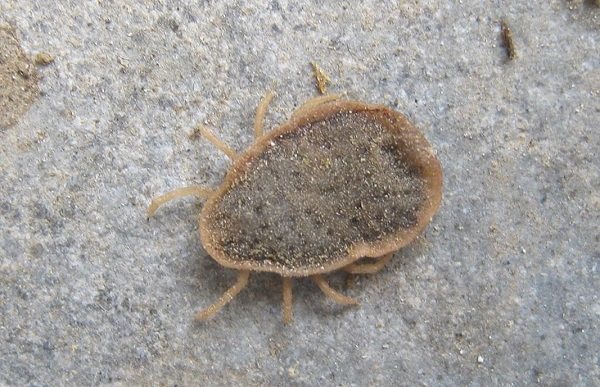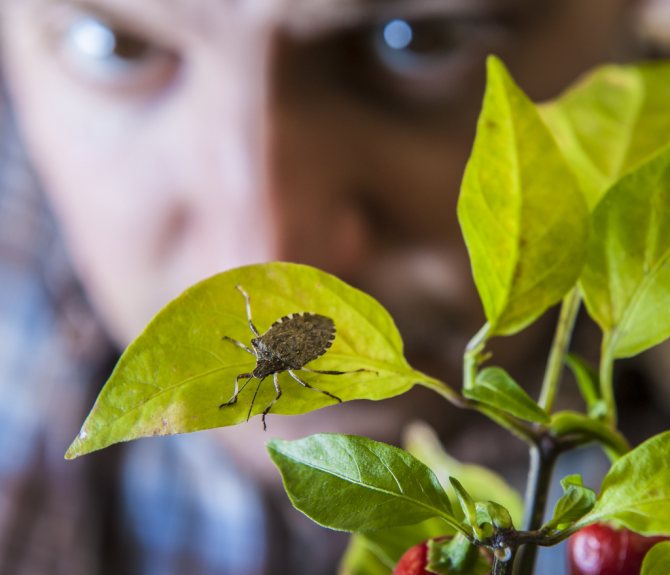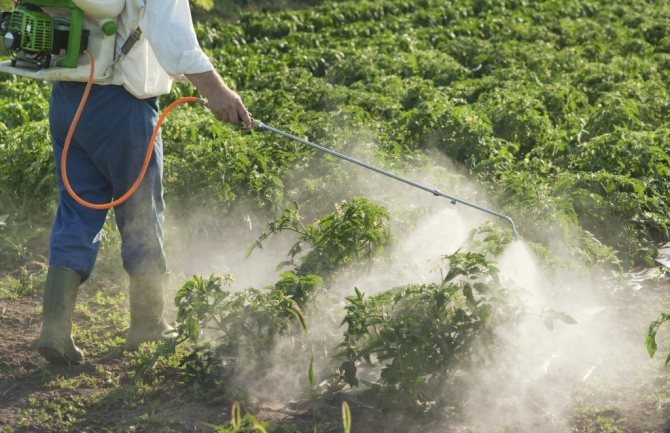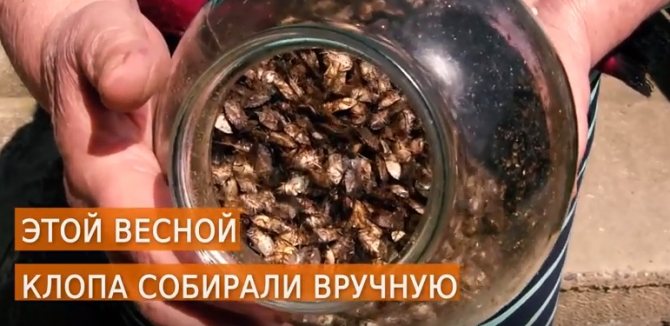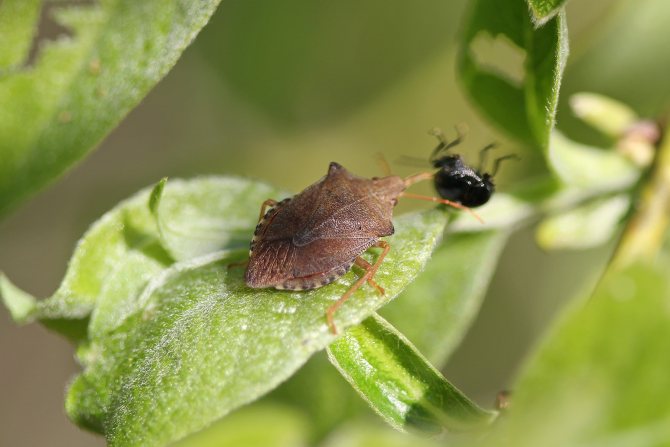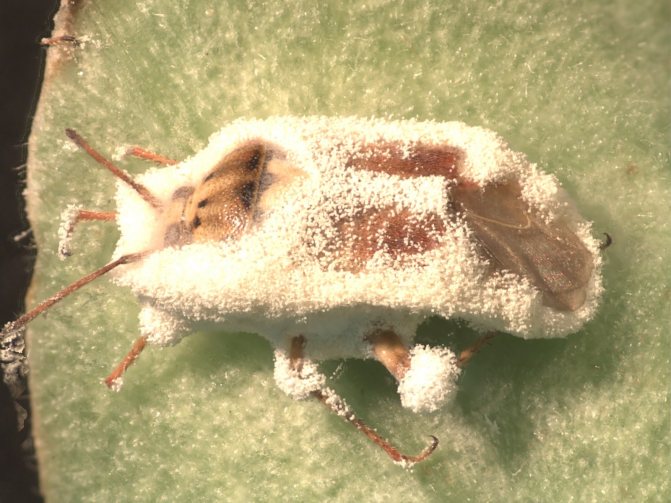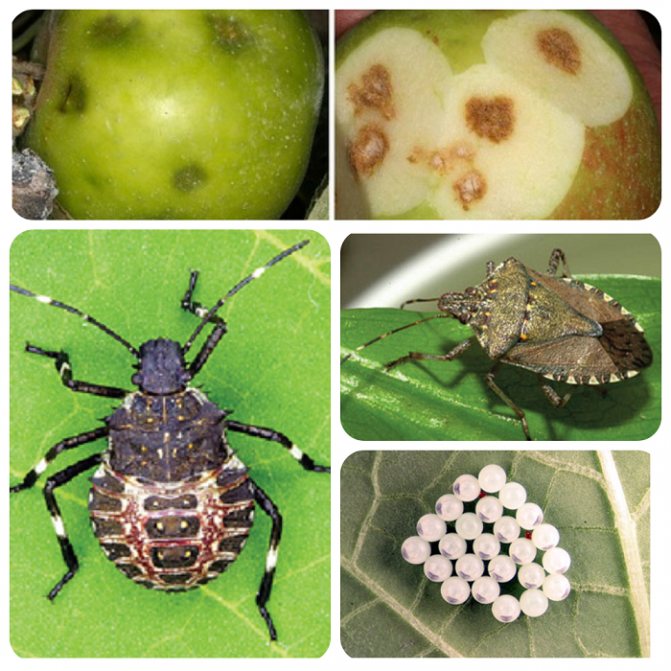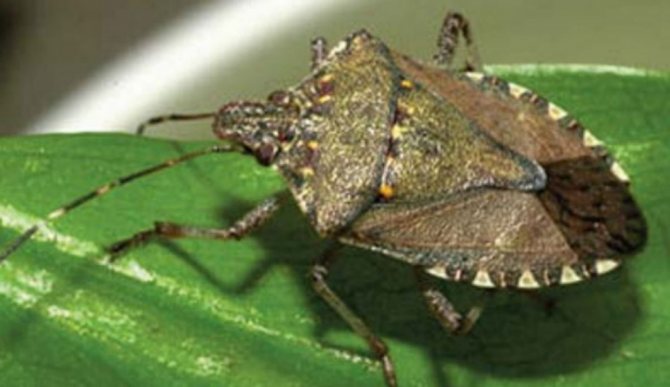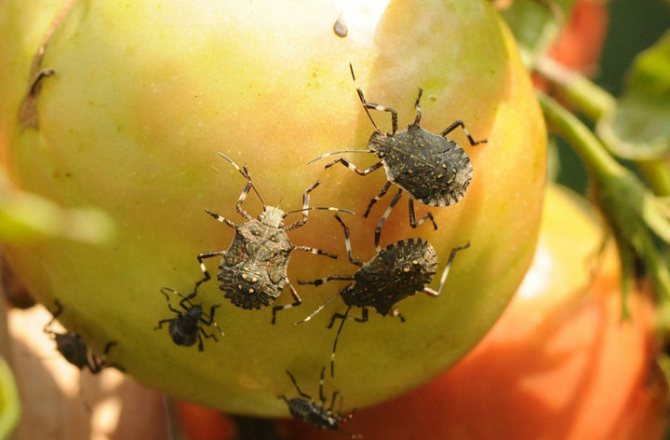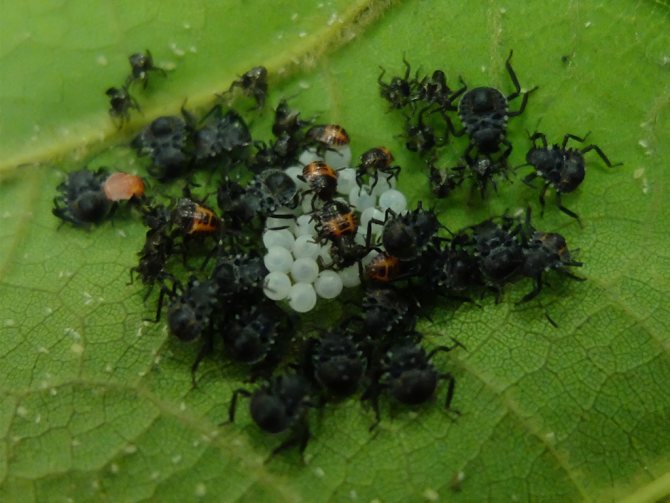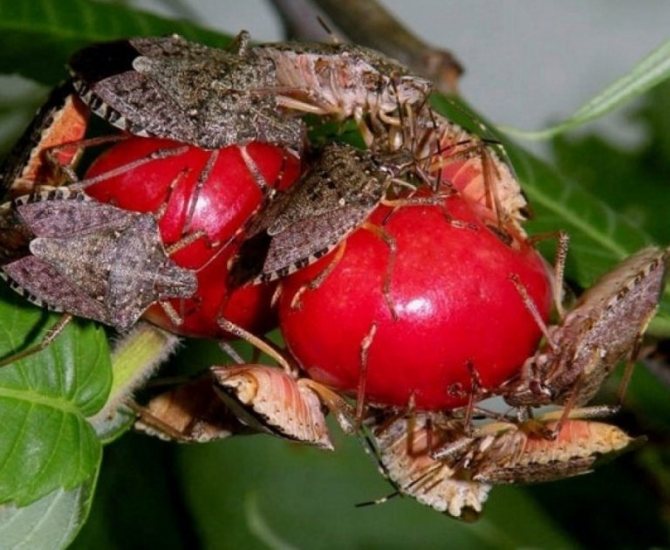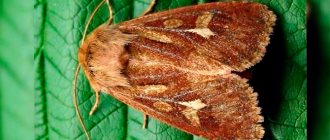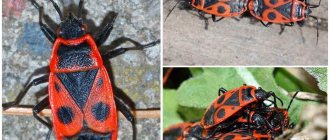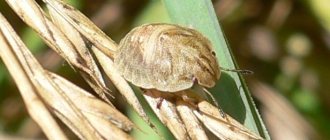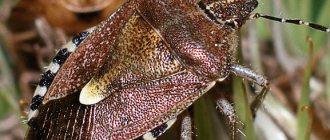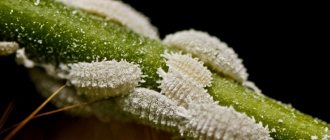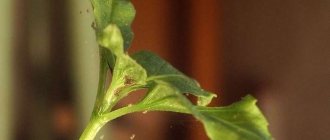The brown marble bug has taken first place in the ranking of pests that threaten the crop industry in Russia this year. If at the beginning of the year in February the Rosselkhoznadzor published mainly reports of cases of detection of a quarantine pest in the supply of citrus fruits from Abkhazia, then by March the messages began to resemble front-line reports with warnings to all Russian regions about the risk of penetration of a harmful insect
In the high-risk zone - the southern regions of Russia
In Sochi, the outbreak of the pest breeding led to the fact that gardeners began to fear: the brown-marble bug will become as commonplace for residents of the southern regions as the Colorado potato beetle for gardeners in the Central Federal District.
But the pest apparently chose Abkhazia as his headquarters. The invasion of the brown marble bug has become a real disaster. The brown marble bug does not differ in fastidiousness and destroys almost all fruit, subtropical, berry, vegetable, grain and leguminous crops encountered on the way.
Losses in the yield of hazelnuts when infested with a brown marble bug are from 40 to 70 percent, peaches and persimmons - 50 percent, grapes, apples and tangerines - up to 30 percent. But these are the main export crops of the Republic of Abkhazia.
By the end of March, the situation became so complicated that the First Deputy Minister of Agriculture of the Russian Federation Dzhambulat Khatuov, accompanied by representatives of the Rosselkhoznadzor, arrived in the Republic of Abkhazia on a working visit.
A representative delegation from Russia examined the areas affected by the insect pest and held consultations with the leadership of the republic. The Abkhaz side received comprehensive support both in material and technical equipment and in terms of methodological materials.
The farmers of the republic were offered five types of drugs to ensure the protection of all crops growing on the territory of the republic. Agricultural producers received special pheromone traps and guidelines for pest control. Dzhambulat Khatuov also suggested that the farmers, within two weeks, until the insects finally “woke up,” to collect the pests by hand and hand them over at a collection point at a price of 1,000 rubles per kilogram.
Nevertheless, in order to prevent the spread of a dangerous quarantine object on the territory of the Russian Federation and preserve the country's export potential, the Rosselkhoznadzor considered it necessary, from April 2, 2020, to introduce temporary restrictions on the import of all plant products from Abkhazia into Russia, including reusable containers and wood packaging material. On April 10, the Rosselkhoznadzor lifted its restrictions, since the situation was brought under control. Only a mechanical method was able to collect about 2 tons of pests!
Social structure and reproduction

Photo: Marble bug Krasnodar Territory
After the onset of warmth, the marbled bug wakes up, he starts eating to gain strength. After about two weeks, they are ready to mate. In colder regions, the appearance of only one generation of offspring per season is possible, in more southern regions - two or three. In the homeland of bugbugs, for example, in the Chinese subtropical regions, up to six generations during the year.
The female lays 20-40 eggs on the lower part of the leaf of the plant, which will then serve as food for the nymphs. During its life, one individual can produce 400 eggs (on average 250). Each light yellow testicle has an elliptical shape (1.6 x 1.3 mm), at the top it is tightly closed with a lid with notches that hold it tenaciously.
At an average temperature of about 20 ° C, the larva emerges from the egg on the 80th day, at a temperature higher than the indicated one by 10 degrees, this period is reduced to 30 days. There are five nymphal ages (immature stages). They vary in size: from the first age - 2.4 mm to the fifth - 12 mm. The transition from one age to another ends with molting. Nymphs resemble adult adults, but they do not have wings; their rudiments appear at the third stage. They have secretions with a smelly liquid, but their ducts are on the back, and the number of segments on the antennae and legs is less, and there are no simple eyes either.
Each age is different in duration:
- The first lasts 10 days at 20 C °, 4 days at 30 C °, the color is reddish-orange. At this time, the nymphs are around the eggs.
- The second takes 16-17 days at 20 ° C and 7 days at 30 ° C. In color, nymphs are similar to adults.
- The third lasts 11-12 days at 20 ° C and 6 days at 30 ° C.
- The fourth ends in 13-14 days at 20 ° C and 6 days at 30 ° C.
- The fifth lasts 20-21 days at 20 ° C and 8-9 days at 30 ° C.
conclusions
In recent years, the invasion of the marble bug has become a natural disaster. Against the background of climatic changes in the world, the habitat of the pest will significantly expand in the near future. Scientists say that an increase in the average temperature in winter by just one degree will lead to a 15% decrease in insect mortality. High fertility, ecological plasticity and migratory activity make the marble bug an almost invincible pest. To date, the measures taken by humans cannot regulate the number of the parasite, they are deterrent and only minimize the harm from its activities. All hope is for the discovery of a new pesticide destructive for bedbugs or the appearance of a natural enemy that will feed on insects while seriously reducing their numbers.
Reproduction
In winter, bush bugs hide in the forests under fallen leaves and are in a suspended state. With the arrival of spring, they leave the winter quarters and fly to gardens, to fields, to shrubs to gain strength after winter and to be nourished with plant sap.
After the recovery period, the mating and egg-laying period begins.
In the warm spring-summer period, bugbugs can lay eggs twice a season, which have the same pale green color as the insect itself. The eggs are very tightly attached to the back of the leaf and in the clutch are arranged in even rows, resembling beadwork. One clutch can contain about 100 eggs.
The egg looks like a barrel or jug, it depends on the type of bug. On the devastated egg, you can see small teeth that held the cap until the larva hatched. The duration of the developmental stage of the egg depends on the temperature conditions, usually the egg develops from a week to a month.
The larva hatched from the egg differs from the sexually mature bug only in the absence of wings, and the color and shape of the larva and the adult bug are similar. A strong shield made of chitin prevents the larva from growing, so in the process of development it drops it five times. This is the most difficult stage of development for an insect. During this period, a large number of larvae cannot shed the shell that restrains their growth, and they die.
Food
The pickiness of the marble bug in food is a big threat to agriculture. The harvest of all fruit trees and other garden plantings is threatened with destruction. Fruits with spots from bite bugs are unsuitable for nutrition, processing.Farmers lose profits from the destruction of corn, legumes, nuts, peaches, apples, persimmons, pears.


Not only the fruit dies, but often the plant itself, since the bug sucks the juice from the stems and leaves. In Abkhazia alone, 32 species of plants were counted that are harmed by the insect. Gardeners suffered losses from spoilage of raspberries, blueberries, sweet peppers, cucumbers, tomatoes.
At all stages of insect development, larvae and adults feed on the same plants. Scientists have noticed that in the absence of cultivated plants, the marble bug feeds on weeds, so the state of hunger does not threaten it.
Phytoplasmosis, which is transmitted by the brown marble bug, is also a threat to plants. The signs of the disease are spots on the hearth, yellowness of leaves.


Appearance and lifestyle
The size of bugs of different species and in different stages of development varies within 0.5-2 cm. The shape of the body of garden parasites is rounded, in adults it is oval, sometimes with a narrower rear part. It is possible to distinguish larvae from adults by the presence of wings in the latter. In any phase of development, insects move actively, crawling over the leaves and fruits of tomatoes.
Only adult specimens hibernate. When the first shoots of greenery appear, they wake up and fly to places rich in fodder plants. At the same time, the breeding period begins.
After mating, the female lays eggs, from which the larvae of the first period hatch within 1-2 weeks: small bugs of greenish or brown color. They grow actively, feeding on plant juices. The larva molts 5 times, and then turns into an adult, capable of reproduction and flight. A large accumulation of larvae on tomato bushes is most often caused by the presence of plants in the beds on which bedbugs feed: weeds or other suitable grasses.
Most bugs avoid the pungent smell of tomatoes and rarely settle on them. But in the absence of suitable nutrition, the larvae are able to suck juices from young shoots or tomato fruits. At the same time, small puncture points appear on them, surrounded by dried tissue.
In rainy weather, spores of pathogenic fungi that cause diseases (late blight, fusarium, etc.) can penetrate into such punctures. The main one is most often only this.
Views
Brown marble bug is a one-of-a-kind species, experts can easily identify the Asian brat. But in areas where the pest is colonized, there are other bugs that are similar in size, color, shape, and do not harm cultivated plants.
Green tree bug. The insect is widespread in many regions. Summer residents often find it in the thickets of raspberries, but the scutellor does not disdain other plants either. By autumn, brownish shades appear in a green outfit, reminiscent of the color of a marble pest. The tree bug feeds not only on plant sap, but also on dead insects.


Nazara is green. A forest dweller that changes color according to the season. By autumn, it turns into a brown bush bug, not noticeable among the variegated foliage. Small wings enhance the ability to move in search of food sources. Inhabits massive colonies in the Krasnodar Territory.


Berry shield bug. The flat body, covered with hairs, is reddish-brown. The abdominal rim with a dotted black and yellow pattern peeps out along the edges of the scutes. The general appearance is rather predatory. Often found on perennial grasses, weeds.
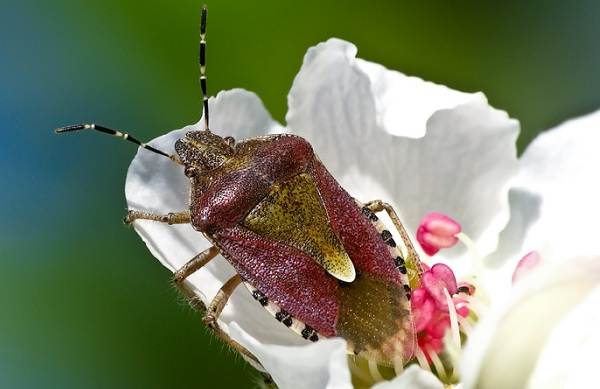

Specialists pay attention to special signs of a dangerous guest, by which it is easy to identify him. Present marble bug in the photo demonstrates:
- light blotches on the back and head;
- parallel zygomatic plates, curving steeply in front;
- a peculiar color of the antennae: the penultimate fragment with a white base and apex, and the last one with only a white base.
Comparison of the marbled appearance with other scutellids avoids confusion. Characteristic signs are observed in the pest at all stages of development, but are especially manifested in adults, adults.
Brown marble bug, control measures
As soon as spring begins to come into its own, the bugs become active and crawl out of wintering places. During this period, it is necessary to examine all possible places of accumulation of pests (for example, under the old bark of trees) and remove them manually. After that, the insects found should be destroyed, and the very place where you found them should be treated with insecticides.
If you notice that necrotic spots have appeared on the bark of trees or shrubs, bumps have formed, and you have seen multiple black dots and holes on the foliage, then most likely you have a brown marble bug in your garden.
With the intervention of a pest, the fruits lose their original taste and attractive appearance, and in citrus crops they generally crumble before ripening.
After the "bites" of bedbugs, the fruits of vegetables and fruits are deformed, and rot appears under the skin.
Photos of fruit deformed by bedbugs:
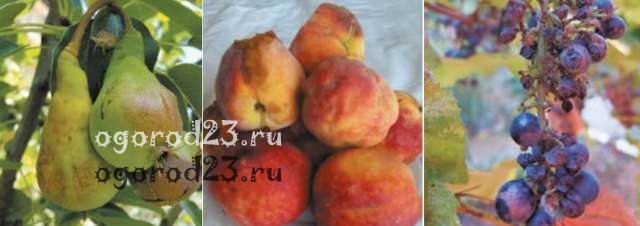

As mentioned above, the bug affects absolutely all types of plants, moreover, in a practical way it has been proven that the insect has acquired immunity to most of the drugs of the pyrethroid group. The fight against this parasite is not easy, but you shouldn't give up. Fruit crops should be treated with insecticides in early spring, until the insects are fully grown.
According to reviews, to date, the best drug for combating brown marble bug is Karate Zeon (4 ml / 10 l of water - double treatment). The second on the list is Clipper (6 ml / 10 l of water - one-time treatment).
Also, it will not be superfluous to try other remedies for the marble bug: Bi-58, Decis Expert, Aktara, Karachar, Break, Gladiator, Sirocco, Aliot, Calypso, Confidor Extra. Good old chlorophos, as well as karbofos, can also be used to combat the pest. But I also met assurances that dichlorvos does not work on the bug. I think this information should be checked in practice.
It is best to use these funds in the evening, taking precautions (mask, gloves). If the infestation of bedbugs is pronounced, then after the first treatment it is recommended to carry out a second one (after 5 or 7 days)
You can also try the so-called folk remedies - garlic, pepper, mustard, laundry soap. These insects do not like the smell of garlic very much. Therefore, you can finely chop the cloves of garlic, add water, insist a little and spray the trees, bushes and other green spaces with the resulting product.
Garlic powder dissolved in water has a similar repelling effect on the pest.
Irrigation of parasites with a water-soap solution gives good results, when used in bugs, the protective cover is damaged, which is why they die.
An aqueous infusion of hot red pepper or mustard powder kills, practically "burns" the marble bug.
A little strange means of struggle, but if this parasite has flown into your house, then "pshik" on it with hairspray - so you instantly immobilize it and subsequently destroy it.
By the way, this member of the family of bush bugs flies at a speed of 3 m / s. In general, of course, you should take care of reliable mosquito nets on the windows in advance and check that there are no cracks.
I also read the following control measures on the Internet:
- wasps willingly lay eggs on bedbug nymphs, which in turn destroys the latter;
- chickens sometimes eat these bugs when there are no other insects;
- mantis insects feed on marble bugs, not only of them, of course, but also of them. There is a video about this on You Tube. Looks like a horror movie ...
Pest in the house
The brown marble bug does not tolerate freezing temperatures. For wintering, he looks for heated buildings, climbs into houses.How is the shield bug dangerous to humans? At the slightest contact with an insect, it gives off a strong unpleasant odor. In some people, it causes an allergic reaction in the form of a runny nose or conjunctivitis. The number of bugs in one house can reach thousands of individuals. The mouth apparatus of an insect in the form of a proboscis is rather weak, so it does not bite human skin. A reaction in the form of dermatitis, itching, or rashes can be caused by contact with the skin of fluids from the body of the bug.
Useful bugs
Some types of bugs are valuable helpers, because they eat eggs, larvae, and adults of insect pests. They protect crops from agricultural land from Colorado beetles, butterfly caterpillars.
Picromerus
Helper insects have pronounced sexual dimorphism. Females are larger and more massive than males. The body of female bugs reaches 15 mm in length. Males have a slender body less than 10 mm in size. The gray body of the picromerus is oval, the limbs are reddish, the antennae and the head are black. Despite the presence of developed wings, insects do not fly. Elytra is used for parachuting from tall plants.
Insects attack in a group and eat a potential victim, for example:
- American whiteflies;
- Colorado beetles;
- caterpillars of the scoop;
- sawflies;
- different types of larvae.
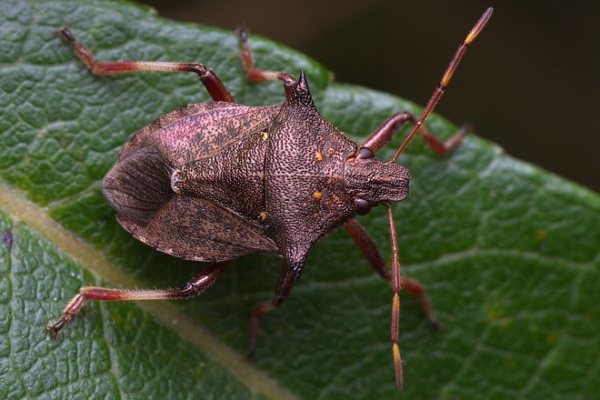

Arma the predatory
The insect feeds on pests of agricultural crops. The size of an adult is up to 14 mm. The carapace is colored brown with many black spots. Armagh is a predatory thermophilic, colonies of bugs inhabit the steppe and forest-steppe zones.
The diet includes:
- caterpillar scoop;
- hawthorn;
- alder leaf beetle;
- Colorado potato beetle and its eggs.
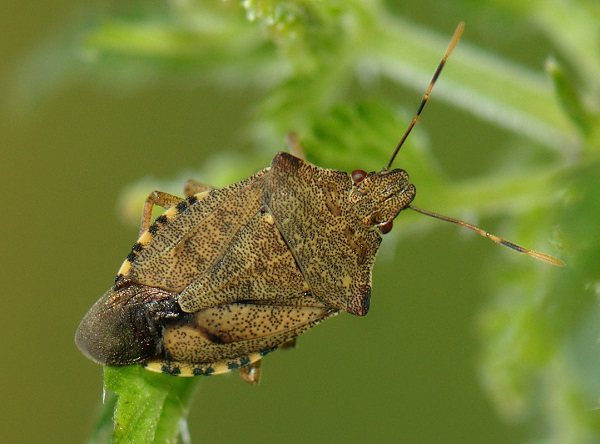

Zicron blue
Zicron blue saves potatoes from Colorado beetles, which are their main food source. It destroys only the eggs of pests, the bugs do not feed on adults. Predators have a blue-green rounded body with a shiny shell. The period of activity falls on the daytime.


Can house bugs fly?
Whether bed bugs fly can be determined by their appearance by carefully examining the parasite with a magnifying glass. Flat, flattened body, elastic chitinous cover. There are no fenders or fenders. The question can be answered with complete confidence - domestic bloodsuckers do not fly.
Bedbugs enter the house, apartment not through open windows, doors, but with infected things, furniture, objects. Or through cracks in the wall, sockets, ventilation grilles from neighbors. Parasitizes in bed when the victim is asleep. Photos of pests are presented below.
This question can be immediately answered negatively, that house bugs do not fly. If possible, it is most likely a rare mutation in this species.
- The history of bedbugs originates in caves, where bat blood was always available in abundance. In these conditions, there was no need for flight, as well as for long-distance travel, since the bugs could feed on sleeping bats all day.
- The absence of wings provides them with a comfortable body geometry - flexibility, which gives them the ability to crawl anywhere, and a plane, thanks to which hungry individuals become practically invulnerable to mechanical stress.
- Wings are not needed by bedbugs today, because parasites move more passively - along with things, furniture and clothes of people. However, they are also capable of making small transitions on their own - along ventilation, along walls, etc.
Popular questions
How does the marble bug feed and reproduce?
The marble bug, which lives in the southern part of Russia, eats a variety of foods: apple trees, pears, grapes, hazelnuts, and some varieties of citrus fruits are at its disposal. In the diet of the pest, there are also representatives of vegetable crops - tomatoes, peppers, corn.
The "mating season" in individuals begins with the arrival of heat. After mating, the first eggs (3-4 dozen each) are laid out by the female bug in early May. After birth, the larva goes through 5 stages of development, after which it grows into an adult.
Can a person stay in a room with bedbugs for a long time?
In theory, a person can live next to bedbugs, however, with prolonged contact, the smell of insects can cause an allergic reaction. And the very fact that you have to spend a long time side by side with unpleasant pests greatly annoys people, disrupting their psycho-emotional background.
Is it possible to eat fruits after disinfecting plants from bedbugs?
The fruits can be eaten after the treatment of plants with chemicals. However, vegetables and fruits must be washed thoroughly.
Can a pheromone parasite trap be used in a living space?
A trap of this type is designed to combat the marble bug in the garden, in the garden.
Thus, the marble bug can be called a true "destroyer" of the crop. The representative of bush bugs is brown and has an unpleasant odor. The insect actively feeds and reproduces in the warm season. Garden, horticultural and ornamental crops suffer from the pest. For a year, the female is able to give life to three generations.
From a theoretical point of view, the parasite is not dangerous to humans. However, it is impossible to exclude the possibility of developing an allergy to the smell of bedbugs in a person living next to bedbugs.
Depending on the season, various methods are used in the fight against parasites: mechanical, chemical, biological.
How to fight?
- Don't crush marble bugs. This will cause the stinky beetle to give off a strong odor.
- Before starting a fight: take precautions.
- Dress so that your arms and legs are completely covered.
- Wear rubber gloves.
- Do not discard a respirator.
- When you start fighting parasites, glasses come in very handy to protect your eyes. Its smell, or accidentally getting the smelly liquid it emits into your eyes can be very painful. Rinse eyes immediately with copious amounts of water and apply eye wash and drops. See your doctor if pain / discomfort persists.
Mechanical method
- When you see one or more marble bugs, suck them up with a vertical bag vacuum cleaner. Stinky beetles give off their scent in a vacuum, causing the car to stink for several weeks. Therefore, sprinkle the inside with strong deodorant to minimize this effect. Avoid using bagless vacuum cleaners. Use bag vacuum cleaners and dispose of the bag after you're done killing the stinkers.
- Alternatively, wrap the stocking around the outside of the vacuum tube and secure with rubber tape. Push the rest of the stocking into the tube and suck in the stinky bugs as usual. This will prevent insects from entering through the vacuum filter.
- You can freeze insects to death. To do this, you need to carefully collect them with paper so as not to scare them, then isolate the insects in a resealable plastic freezer bag or an airtight, freeze-safe container. Place the container in the freezer for a few days to kill them. Make sure the container or bag is tightly closed. Otherwise, you risk contaminating the contents of your freezer.
- Place a glass on the beetle and leave it until it dies on its own from its own toxic emissions. Then you need to quickly raise the glass. Sweep the dead beetle into the trash.
This can only be done outdoors because the chemical builds up and you can actually see brown fumes.


- Can you drown marble bugs in the toilet without using soapy water if you collected them with toilet paper or paper towels and threw them in the toilet? Within a minute or two, they'll be guaranteed to drown, but wrapping them in toilet paper or paper towel will ensure they are completely submerged.
- Can a battery-powered fly swatter kill a stinker? Any kind of fly swatter can kill an insect, but it must be borne in mind that before dying, the bug will release a smelly smell that will attract its fellows. Once you quickly clean and deodorize the area, it becomes a huge problem.
Chemical method
As soon as you see a marble bug, you need to spray it with an aerosol insecticide, which, according to the instructions, kills on contact. But you have to understand, the death of the bug "on contact" will not necessarily happen as quickly as the term implies. These chemicals usually begin to attack the nervous system of the marble bug after it has dried, and it may take several hours after initial contact before the beetle dies.
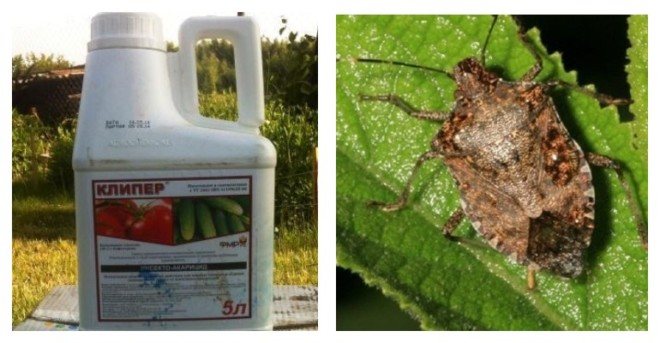

It is important to apply insecticides by following the directions on the label. Spray or spray on any area that you suspect smelly insects are hiding in.
Leftover aerosols work best when sprayed along window sills, doorways, and baseboards. They can also work when you spray them liberally after cleaning in an attic, crawl space or interior wall.
You can also spray insecticide around your home outside. Spray outdoor pesticide residues around the base of your home. Marble bugs always come in from the street, so this will protect you from insects that are still trying to enter your territory.
Traditional methods
- Use a nicotine solution. Soak a pack of cigarettes in 4 liters of warm water. Strain the solution and mix with 2 tablespoons (30 ml) of dish detergent.


Fill a spray can with this solution and spray it thoroughly with the marble bug. Liquid dish detergent allows the solution to adhere more effectively to the insect, and nicotine poisons the marble bug.
Wear disposable gloves when handling nicotine solution to avoid accidentally absorbing the poison yourself through your skin.


- You can paralyze marble bugs with hairspray. Spray hairspray on each marble bug to stop the pest from moving.
Hairspray alone won't kill the insect, but it will immobilize it, inhibiting free movement and making it easier to apply a chemical that will kill the pest.
Make sure you use the most sticky hairspray. Fortunately, cheap brands tend to be stickier than expensive ones.


- Kill the bugs with rubbing alcohol, bleach, or ammonia. Fill a glass jar with one of these chemicals and throw stinkers in there when you come across them.
Do not mix these chemicals. By combining these chemicals, vapors can be produced that are fatal to humans.
Use a popsicle stick, pick them up with a rubber glove, or pick them up with tweezers.
You can also dilute one part of rubbing alcohol three times with water inside the spray bottle. A parasite attack will also be successful. Alcohol, getting on the surface of the insect, dries it up and eventually destroys it.
- Kill the marble bug with CryoPharma, a wart remover that freezes not only viruses, but insects as well. Spray the product directly onto the marbled creature. The beetle will instantly freeze and all you have to do is flush it down the toilet.
- Sprinkle the stinky with hot peppers or hot sauce. Fill a spray can with hot sauce or liquefied hot peppers. Pour a sharp insecticide on each bug.Hot peppers can burn human skin and eyes if mishandled. Likewise, peppers can burn the waxy surface of a harmful turtle, eventually destroying it. Wash your hands after handling hot peppers and hot sauce to avoid accidentally irritating your eyes.
- You can use a wax remover. If you manage to drop the drug on the back of each individual pest turtle, the insect should die within one or two minutes. But keep in mind that accidental splashing on carpet or other surfaces can cause stains. For best results, immobilize the insect with hairspray or place it in a glass jar before using the candle wax remover similarly removes the wax coating on the outside of the stinky turtle's shell, thereby destroying the inner membranes.


Use white vinegar. Place a tablespoon / teaspoon of white vinegar in a container, not overly large. Grab the marble bug with tweezers, an empty container with a lid, and / or use gloves.
Throw in vinegar. They die immediately without firing their stinking bomb.
Biological way
In Asia and America, there are parasites that feed on the eggs of marble bugs and attack nymphs. The influence of natural enemies on the populations of smelly turtles in Europe is unknown.
In the southern subtropics of Russia, local natural enemies are not effective against populations of the marble bug in its invasive range. Predators feeding on stinkers have been observed, but low control rates have been reported, typically below 20%. In its natural range, the harmful turtle experiences up to 70% of attacks on eggs by other parasites.
Traps
Set up the insect electric shock system. Place the bug in a dark attic or closet. Like most insects, smelly insects gravitate towards light sources. By placing the device in a dark room, the electric current system light becomes more attractive to smelly insects. When they get close to the light, they are instantly electrocuted and killed before they have a chance to release the stink. Sweep or vacuum the area after a few days to remove dead marble bugs.
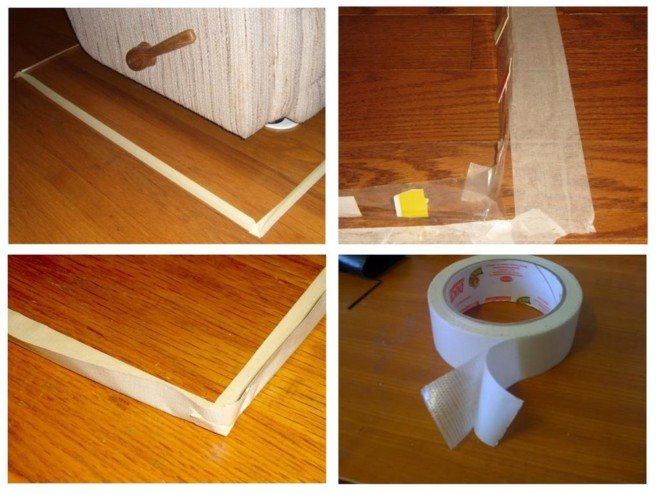

Lay out the glue traps. Place Velcro or other sticky traps around windows, doorways, vents, and cracks. Marble bugs get trapped and stick. Unable to search for food, insects will starve to death. Throw away the glue trap after you've collected a few parasites.
- You may be wondering if there is a way to bait them to attract marble bugs and kill them en masse. The tip is: Leave the candies and it will attract them. You can stick the candy to the sticky trap.
Remember that stinkers will actively smell when they get stuck in a trap.
What is often confused with?
Often the soldier bug is confused with the firefighter beetle, although they are not very similar to each other.
Firefighter beetle (Cantharis rustica) is a type of soft beetle found throughout southern Russia. This beetle is one and a half to two times longer than the soldier and has a different color (brown elytra and orange abdomen), they are useful for humans, because they feed on eggs and young insects, thus exterminating many pests.
These beetles fly perfectly, and also make masonry in rotten wood. In fact, the soldier is not a beetle at all, since beetles belong to the order of coleoptera, and he belongs to the order of hemipterans.
Why are these insects so often confused? It's very simple, people confuse a soldier bug with a firefighter beetle because of the fiery red color of its winged wings.
Lifestyle and habitat
The historical homeland of the marble bug is the territory of Southeast Asia (China, Japan, Taiwan, Vietnam, the countries of the Korean Peninsula). Since the 90s of the last century, the area has expanded significantly, it began to cover the southern provinces of Canada, most of the states of America.
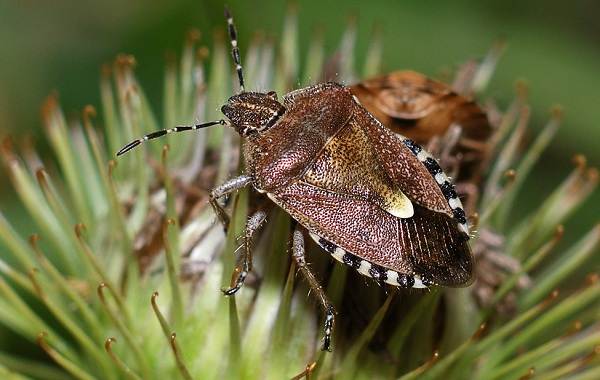

After 10 years, the Asiatic bug was found in Switzerland, New Zealand, England. Together with the luggage of tourists, the insects moved to new territories, successfully adapted there.
Since 2014, the pest has been found in Russia. The first appearances were recorded in Sochi, Krasnodar Territory. The humid and warm climate contributed to the spread of the marble bug, outbreaks of mass reproduction and crop losses began to be recorded.
Rosselkhoznadzor is authorized to impose sanctions on bedbug-infested products imported into the Russian Federation, but this is not enough to get rid of the pest everywhere.
The bug has practically no natural enemies due to the odor of this insect. Only in Asian countries there is a local wasp that parasitizes on bed bug eggs. In other regions, attempts were made to bait bedbugs with insecticides, but the insects turned out to be insensitive to chemicals. Fighting the marble bug very difficult.
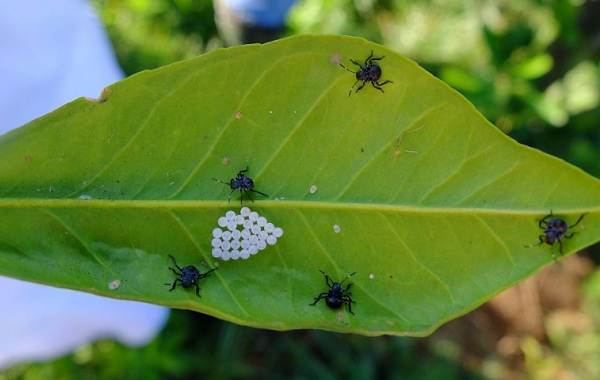

In the photo, larvae and juveniles of the marble bug
Heat-loving bugs are active in the summer, when they feed hard and breed. With the onset of cold weather, insects begin to search for shelters for wintering.
Large clusters of brown bush bugs can be found in barns, country houses, and private buildings. Many people wonder what is the danger of a marble bug, as they fear not only an unpleasant odor, but also bites, the spread of infection.
Bedbugs rarely bite, but they can show aggression during the breeding season, although the proboscis is not adapted for piercing human skin. The puncture site turns red, itching appears, an allergic rash on the skin, swelling is possible.
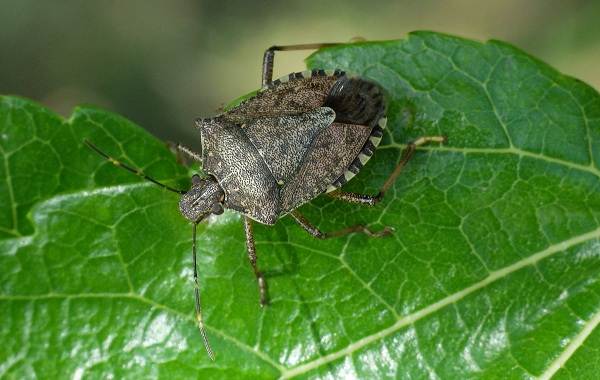

To eliminate the effects of inflammation, it is recommended to rinse the bite area with soapy water, apply cold. You can use a special pharmacy ointment against insect bites with antibacterial properties to avoid an acute allergic reaction. The period of diapause is associated with the cessation of reproductive activity, bedbugs save energy for the spring awakening.
Having sat in the cracks, gaps of the cladding, insects sensitively catch an increase in daylight hours, a change in temperature. Sometimes the warmth of human habitation attracts bedbugs, which tend to incandescent lamps, gather on the ceiling. Such invasions do not make people happy.
Reproduction
In the spring, starting from the third decade, adults settle on plants. When the air temperature stabilizes at around 10-12 degrees, insects begin their "mating season". Pests mate, the first eggs appear in early May. The eggs are laid by females in groups of several dozen and are attached to the inside of the leaf of fruit and vegetable crops.
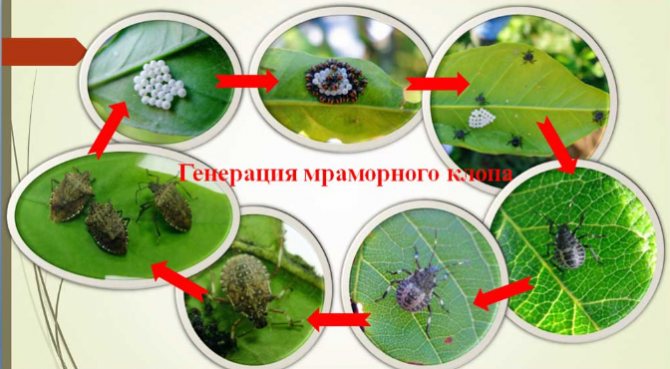

After the moment of birth, the larvae remain on the leaf for several days. As they grow and develop, they go through 5 larval stages. The age stage is determined by the appearance and size of the body.
Inhabiting the territory of southern Russia, the insect is capable of breeding 3 generations of offspring. The first falls on the end of June, the second - in the first days of August, the third - in the middle of October.
Harmless bedbugs
These varieties are not harmful to humans, domestic animals, livestock and agricultural land.
Soldier bug
They belong to the family of redbirds. They do not pose a threat to humans, they are not carriers of dangerous diseases. The soldiers are painted black, the elytra and the back of the exoskeleton are patterned in red. The hind wings are absent, there is an elongated proboscis. The diet of the soldiers is based on the juices of fruit trees, liquid from the leaves, do not harm agricultural land.The leaves do not dry out after punctures, the fruits do not deteriorate.


Alder bug
The alder brood bug got its name from the female, which chooses only alder for laying eggs. Refers to arboreal shield bugs. It has an elongated body reaching a length of 8 mm. Colored light brown with many dark spots. On the border of the wings, black and yellow stripes alternate.
Insects spend most of their lives in trees. Females do not leave eggs and hatched larvae until they can independently get food and exist outside the nest. For humans, hens do not pose a threat.
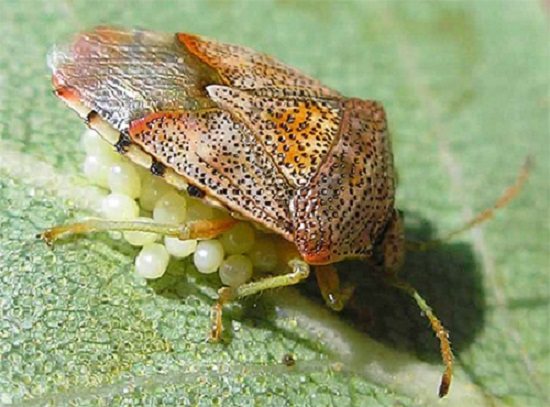

Insect pests
In nature, there are a large number of harmful garden bugs. They can be conditionally divided into two groups:
- country bugs - parasitizing only on fruit and berry plants;
- plant pests - they feed on the foliage of wild plants and can easily switch to horticultural crops.
Forest green shtitnik
Many summer residents call forest bugs green garden bugs. The size of an adult reaches a length of up to 1.5 cm. The bright green body has slightly noticeable notches at the edges. Forest beetles breed in places of feeding so that larvae hatching from eggs do not have to look for food for a long time. The female lays about a hundred eggs, attaching them very tightly to the stems of plants. After 1.5 weeks, larvae appear from them, which turn into adults within 30 days.
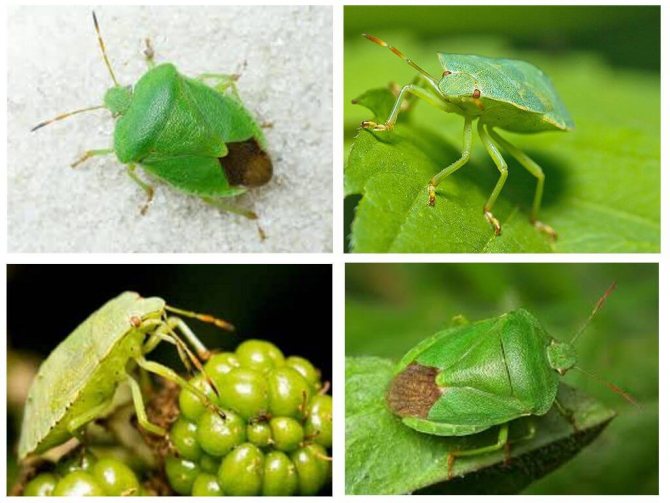

Forest shtitnik
Green bugs live on trees. Wildlife and parklands are their main source of food. However, very often such garden bugs can be found in the garden and vegetable garden. First of all, the pest attacks the raspberry bushes, there may also be bedbugs on the currants. Buckthorn and herbaceous plants do not disdain.
Eurydema north
Garden cruciferous bug or northern eurydema is one of the most dangerous pests, the body size of which does not exceed 8 mm. Its bright color and beautiful pattern on the back is very reminiscent of the appearance of a soldier's bug, but the size of the harm it causes is much more tangible. The insect's whiskers are covered with short hairs. Massively cruciferous fleas increase their population in hot weather, as a result of which they are able to destroy planted cabbage or other seedlings in just a few days.
Such garden bugs, plant pests, eat the leaves of radish, cabbage, radish and other vegetable crops. Insect attacks rarely survive any plantings.
Berry bug


Berry bug
This garden bug is known to many as the stink bug. The insect has a bright burgundy color. One of its distinguishing features is the unpleasant odor that it emits upon contact. The female is able to lay up to 400 eggs with a hard coating and yellowish hairs. The pest goes through 5 stages of development. Moreover, after the first two, his black body acquires a burgundy color, and the abdomen becomes yellow. The berry stink bug spends winter in the adult stage, and wakes up only in the middle of spring.
Cucumber bug
One of the smallest insects of this family, the black body of which does not exceed 3 mm. However, this does not prevent him from jumping well. The garden pest can not always be seen, since it settles mainly on the underside of the leaf plate. The plant parasite lays eggs in the second half of summer, remaining to winter in this form. The larvae that appeared in May settle on the lower part of the leaf. The garden bug is able to infect entire greenhouses by eating seedlings of cucumbers, bell peppers, eggplants and tomatoes.
Pearl lacemaker


Pearl lacemaker
Many are surprised by the appearance of this garden pest. The nondescript body of beige shades has lace edges, the pattern of which repeats the pattern of the back. An individual develops according to an incomplete type. Insects are very fertile - the female can lay up to 400 eggs. It will take about 4 weeks for the larva to become an adult.
By the name of this garden insect, one can determine its favorite habitats, they are pears, apple trees, apricots, plums and other fruit trees.
Shield Bug
Another garden representative who is the worst enemy of agriculture. The pest bug is a relatively large insect, the body size of which reaches up to 13 mm. He was given this name because his color is very similar to the land turtle. Developed wings enable the insect to travel long distances. The life span of the pest is no more than 11 months. The plant bug reproduces very quickly - in one season the female manages to lay about 15 egg-laying.
The question of what garden bugs of this species eat will arise for everyone who finds a similar individual in their garden.
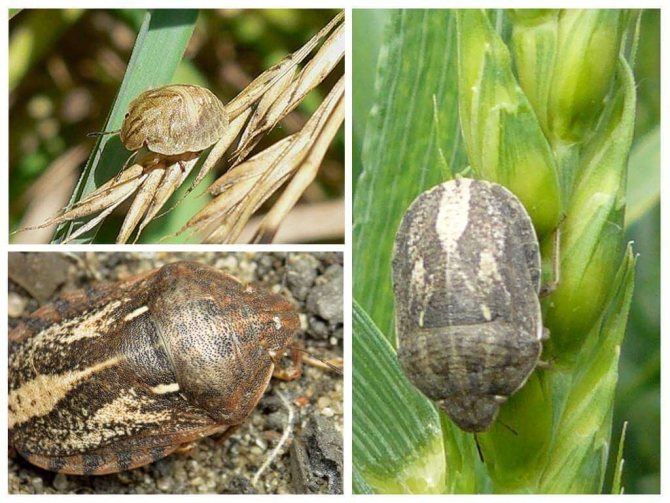

Bug turtle
Lifestyle
The marble bug first appeared on the territory of East Asia in 1998. Therefore, it is considered a native of this country. Distributed now in Turkey, Georgia, Abkhazia, Southeast Asia and Europe. The parasite is unpretentious to living conditions, so it successfully gets along on the street and in houses. Able to settle in bird nests and animal burrows.
Bedbugs thaw with the first spring warmth, and intensively begin to look for food sources, first attacking young shoots. With their massive attacks, they destroy solid areas of fruit and berry and other plantations.
Since April, the female marble bug starts laying eggs, up to 25 eggs at a time. With a thorough examination of plants, they are found on the reverse side of the leaf plates. After 3 weeks, larvae hatch from them, having 5 stages of development. Each has inherent external features in color:
- Newborns are red or orange.
- The larvae darken, becoming almost black.
In the third and subsequent stages, the insect acquires a brown-white tonality.
Bed bugs breed up to 3 times a year:
- early May - late June;
- the last decade of June - early August;
- Aug. Sept.
Then insects go into hibernation, and in spring they wake up and resume active harmful activity.


Interesting Facts
- In order to preserve the potato crop, it is necessary to release II, III ages on the field. They are the most voracious. Perillus outlets ensure the preservation of the harvest during the development of the larvae of the most harmful first generation of the Colorado potato beetle.
- In order for the bug to take root on the territory of Russia, you need to use additional bedbug complementary foods. Because the bug wakes up from hibernation 40-45 days earlier than the Colorado potato beetle. Because of this difference, he may not survive and die. To avoid this, it is necessary to teach the bug to eat other insects or to be able to feed it.
- Perillus prefer to feed on eggs and larvae of the Colorado potato beetle. But sometimes an adult can also eat. As a rule, crippled or dead beetles become victims.
The perillus bug is a unique insect that is harmless to humans and plants, but can become a real biological weapon in the fight against the Colorado potato beetle. If it is fully acclimatized, then you can save not only energy on collecting the pest beetle from potatoes, but also save on the purchase of chemicals.
What harm does it do?
The appearance of the marbled beetle is one of the biggest problems for farmers. The bug poses a danger to more than 100 plant species, including agricultural crops. The insect is indiscriminate in food, its diet includes:
- fruits: apples, pears, peaches and apricots;
- berry crops: rose hips, sea buckthorn, grapes, currants, cherries, raspberries, etc.
- subtropical crops: citrus, fig, persimmon and olive;
- nut-bearing: hazelnuts, peanuts, cashews and many others. others;
- grains and legumes: peas, beans, beans, soybeans, wheat, corn, barley;
- vegetables: peppers, tomatoes, eggplants, cucumbers;
- decorative tree crops: sycamore, holly, cercis.
emkost_bak
fgbucnmvl
alex_jem2017
If you do not start fighting the insect in time, it will not only cause colossal damage to the crop, but it can also destroy it.
The larva and the adult feed on the same thing, piercing the outer tissues of plants and sucking out the juice from them. Because of this, the stems become bumpy, and the tissue formed under the bark resembles cotton wool. Affected fruits and vegetables lose their true taste and do not have time to ripen, crumble to the ground or start to rot on it (cucumbers, pumpkin, etc.).
We also recommend looking at:
- Blackberry pests and control in the garden
Experienced gardeners know firsthand what blackberry pests are. Fighting them in the garden or at the dacha takes a lot of their time. ...
- Cabbage, how to treat pests - practical advice
Most gardeners want their cabbage to grow. How to treat a carefully grown crop from pests, which treatment is more effective? Unfortunately, not only we love cabbage, ...
- White cicada - fighting with it in the garden, vegetable garden - features, difficulties, preparations
For more than one year, the white leafhopper (Metcalfa pruinosa Say) has been settling in the Kuban region on all plants in our region. This is a very dangerous pest ...
- Fighting beetle, one of the popular ways
Someone on the site has the worst enemies - a bear or a wireworm. And someone has a crunch. The fight against crunchy - can it be effective? I, too…
Preventive actions
People should apply preventive methods to protect their homes and plants if they are in insect habitats. You will need to regularly carry out insecticide treatments, set up traps, and follow the instructions of specialists. To protect your living space from marble bugs you will need:
- Get rid of gaps and crevices. To eliminate cracks, polyurethane foam is suitable.
- Install or replace screens on windows and engineered openings. Pests are large in size, so the simplest options are suitable for protection.
- Place traps. Light or mechanical traps are placed near a private house.
You can collect parasites in soapy water. In such a liquid, they will die in a short time. First of all, it is necessary to protect the house and other buildings from penetration. Even in the conditions of the South of Russia, it is extremely problematic for parasites to survive in winter if they do not get into a warm room.
Prevention of damage to fruit crops is the use of chemicals. It is required to select funds that will not harm the plant and the person. After processing, the fruits must retain their original qualities.
The marble bug is a unique pest due to the lack of natural enemies and resistance to some insecticides. To combat it, you will need to use an integrated approach. First of all, you need to carry out chemical treatment. To protect living quarters, you will need to close up all the cracks and use a mosquito net. If a person is engaged in plant growing in places where a pest lives, he will need to seek help from specialists in the fight against parasites. Otherwise, serious losses will be incurred.
Marble bug in your home
Small marble bugs can end up in your bed, especially if you live in your own home or near a forest. In this case, find out where there are cracks that go out into the street. Check the same frame on the window even for the most microscopic holes. Perhaps in your house there are still windows with cracks or a small opening from the outside. Also, if you have window or wall-mounted air conditioners, marble bugs can enter through them. If you have a mosquito net on a window or balcony door, there may be holes in it. The foundation of the house is another entry point.
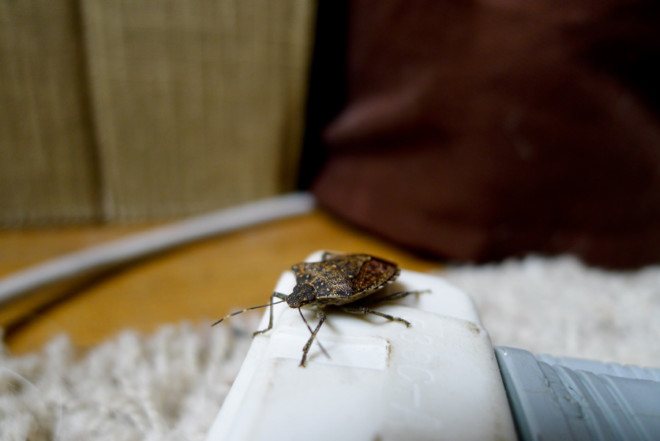

ANY tiny hole can be a good road for the marble bug into your home.
Insulate your home to prevent new marble bugs from forming.No method of eradication will kill future marble bug infestations. The only way to get rid of them in the long run is to cover up any vents, cracks and openings leading from the outside to prevent more from re-entering.
If you crush an apartment stink
If you crush marble bugs in your home, they will release an odor that will attract even more new insects. But you can kill them using a spray or trap without crushing them.
Population and status of the species
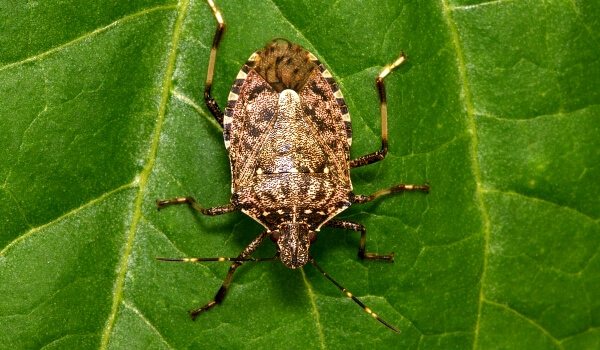

Photo: Marble bug insect
The number of these insects is growing and it is difficult to control it. Accidentally finding themselves in conditions where they have almost no enemies in nature, the scutellids began to multiply rapidly. Insects that can effectively regulate their population live in the regions from which the marbled originally appeared. He quickly adapted to new climatic conditions, and the warming of recent years, contributes to the survival and an increase in the number of pests.
The best way to fight can be a frosty winter. But scientists do not rely on nature and try different ways of fighting. Along with effective insecticidal preparations that destroy beneficial insects, biological methods are used.
Tests with fungi that infect pests have shown that the bover species infects up to 80% of bugs. The metaricium fungus was found to be less effective. The difficulty in using them is that high humidity is needed to combat drugs based on mycoses, and the insect chooses dry places for wintering. Traps with pheromones are not always effective: firstly, they do not attract larvae, and secondly, adults also do not always react to them.
There are high-risk areas where these shit bugs can appear and breed:
- South American countries: they can feel great in Brazil, Uruguay, Argentina;
- In the northern regions of Africa: Angola, Congo, Zambia;
- New Zealand, southern regions of Australia;
- All of Europe within 30 ° -60 ° latitudes;
- In the Russian Federation, it can comfortably reproduce in the south of the Rostov region, quickly spreads across the Krasnodar and Stavropol regions;
- Where winters are colder, the pest may appear periodically, migrating from the south.
For several years, the marble bug has multiplied so much that it is becoming an ecological disaster. The measures taken are of a deterrent form and cannot drastically affect the increase in the population of this pest. High fertility, flexibility in relation to food and climatic conditions, active migration, adaptability to chemicals - this nullifies all attempts to control the bed bug.
Tags:
- Halyomorpha
- Pentatomoidea
- Pentatomomorpha
- Animals of Abkhazia
- Animals of Belarus
- Animals of Eurasia
- Animals of Canada
- Animals of China
- Animals of Korea
- Forest animals
- Animals starting with the letter K
- Animals starting with the letter M
- Animals of the fields
- Animals of Russia
- Animals of North America
- Animals of Ukraine
- Animals of South America
- Animals of Japan
- Bedbugs
- True shield bugs
- Hemiptera
- Arthropods
Description
The marble bug is an insect from the Hemiptera order, the Shitnik family. The name was given for the original color - dark brown, with a marble pattern. The lower part is lighter or white, sometimes with small dark specks. The body is pear-shaped, flattened, 14-16 mm long.


A characteristic feature of the parasite is an unpleasant smell, reminiscent of burnt rubber, with an admixture of cilantro. Therefore, such a newcomer will not remain unnoticed in the house. In the wild, the stench plays a protective function for the insect against predatory animals.
The marble bug causes irreparable harm to agriculture: it eats crops, crops, fruits and other plants. Last year, the vast lands of Georgia and Abkhazia suffered from harmful invasions, therefore, methods of counteraction began to be intensively developed.
What plants are dangerous for a marble bug
This serious adversary is capable of causing significant damage to all green spaces. He likes fruit trees and shrubs, citrus fruits, cereals and legumes, berries, melons, flowers.


It's even scary to look at the photo below ... What kind of nut harvest can we talk about?! ..
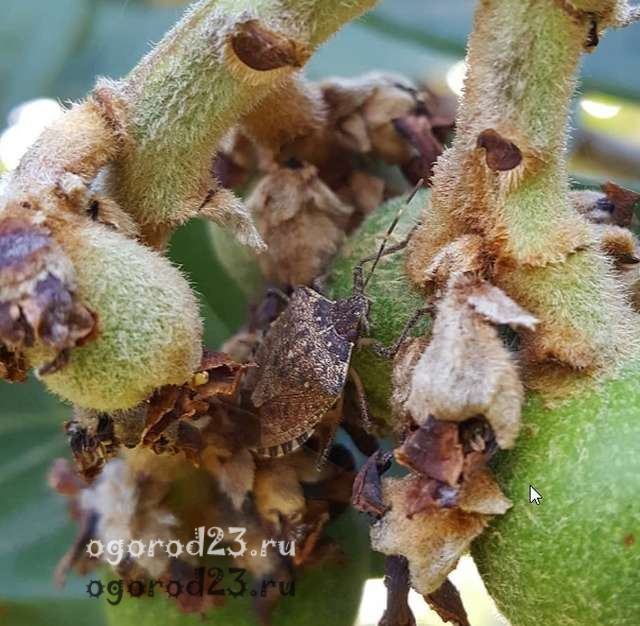

There have always been a lot of various scabbug bugs on different plants in our Kuban. We called them "stinkers." Indeed, if you crush it or accidentally touch it, shaking it off the berries, you immediately feel a not very pleasant smell. And even the taste of the berries, which got the bug discharge, became unpleasant.
But the brown marble bug is a new pest. This was not the case in our childhood. This one is especially dangerous.
Looking at the photo below, it becomes clear that the pepper harvest cannot be expected on the site where this pest settled. And not only pepper ... Alas ...


What is this new enemy? Sticks to tomatoes, ugh. Who else has such aliens? I live in Goryachy Klyuch. Galina Arkhipova
Bulk of this stink. This is a marble bug.
And what is behind the statements of agricultural. And these are the main export crops of this republic. In Abkhazia, the bug invasion is called "winged horror". Residents, in order to somehow reduce the number of pests, collected insects that hid in their houses for the winter with vacuum cleaners, there were so many of them.
In the video below, L.Yu. Shonia, chief agronomist of the Gal district of the Republic of Abkhazia.
The brown marble smelly bug (Holyomorpha halys Stal.) Has never been encountered in the Kuban before.
This dangerous pest is included in the Unified List of Quarantine Objects of the Eurasian Economic Union (EEC).
The homeland of the brown marble bug is the countries of East Asia: China, Japan, North and South Korea, Taiwan and Vietnam. In the USA it appeared for the first time in 1996, in Europe - in 2004. And in October 2016 it was seen in Krasnodar. It appeared almost simultaneously with the appearance on the shelves of such fruits as feijoa, lemons, oranges, persimmons, which were brought from the territories inhabited by this bug. The pest flies well, so it was not difficult for him to spread to the southern regions.
Invasion of the pest, photo:


The harm or benefit of the bug
Marble bugs are more dangerous to gardens than to humans. We only get rid of them because we don't want insects to be in or near our homes. Basically, if you are not a tree, they are harmless. At the moment they are not considered to be carriers of the parasites.
What does the brown marble bug eat?
What vegetation and trees attract marble bugs the most? They are not picky not foodies. They destroy gardens and forests, as well as houseplants and even cardboard - they eat a lot of things.
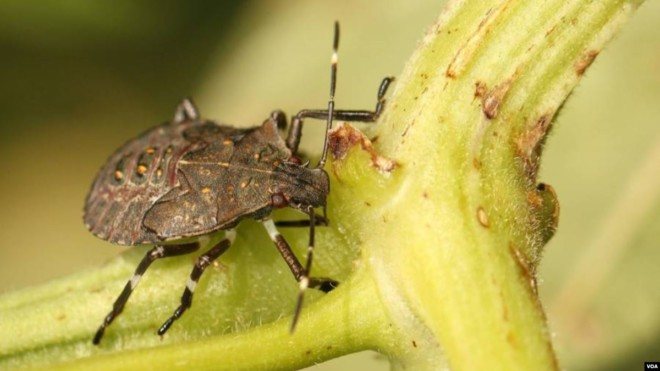

It feeds on numerous fruits, vegetables, field crops, ornamental plants and native vegetation in its natural and invaded zones. The harmful turtle is a real polyphagous turtle, there are more than 300 species of cultivated plants from 49 families on which it feeds in its range.
Harm
Marble beetles have spread throughout the world. They are registered in 41 states and the District of Columbia in the United States. Isolated populations also exist in Switzerland, France, Italy and Canada. In Russia, he is also often found. Recent discoveries have also been reported in Germany and Liechtenstein. It is the main pest in the Central Atlantic Ocean and the Pacific Northwest. In the central Atlantic Ocean, serious crop losses have been reported since 2010 for apples, peaches, sweet corn, peppers, tomatoes and spring crops such as field corn and soybeans.
Benefit
There is no benefit from marble bugs, but if you find a parasite on your tomatoes, you need to urgently mobilize to fight it.
Bed bugs are parasites
Parasitic bugs are blood-sucking insects that settle closer to humans. The danger is that they can carry infectious and viral diseases.
Bedding
Bed bugs are the main types of domestic bugs and feed exclusively on the blood of mammals. They often settle in sleeping places of humans and pets. In case of danger, they emit an unpleasant bug odor.


Cimex lectularius
It is a wingless flat-shaped insect. Adults grow up to 8 mm in size. The exoskeleton of the hungry parasite is dirty yellow or brown. After saturation with blood, it changes color to black or dark red.
The eggs of the parasites resemble small grains of rice - up to 1 mm in length. Painted white. Due to the content of a specific secret produced by the internal glands, when the eggs are crushed, they emit a pungent unpleasant odor.


Cimex adjunctus
Alternative names are white, mouse bug. It feeds on the blood of bats, rarely settles in human bedding. It does not differ in appearance from Cimex lectularius. The length of the body is from 3 to 8.5 mm, depending on the degree of saturation of the parasite with blood. Females are larger than males. A distinctive feature of a mouse bug is the presence of white hairs around the head. Insects do not have front or hind wings.
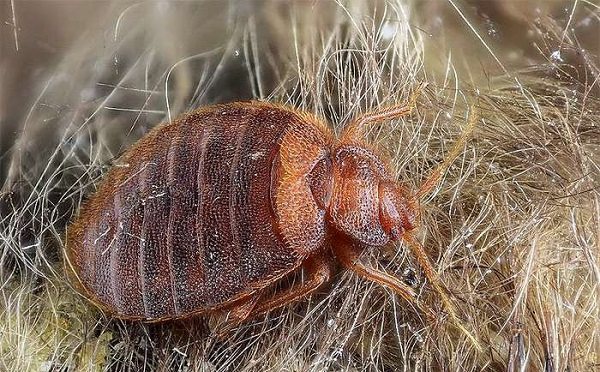

Cimex hemipterus
The bug Cimex hemipterus is a blood-sucking insect. Parasites prefer to settle closer to humans. The bugs Cimex lectularius, with which they are similar in appearance, are actively displaced. Distinctive features are thinner elongated limbs and a less rounded body. With the onset of dusk, the activity of parasites decreases. They are highly resistant to chemical insecticides.


Oeciacus
An alternative name is the swallow bug, which parasitizes the bird of the same name. The rounded body is white. Distributed in the European part of Russia.
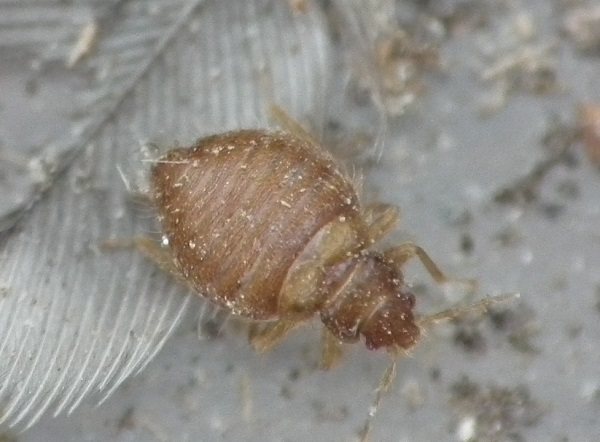

Triatomine bug (Triatominae)
Belongs to the family of predators, is nocturnal. The insect has an elongated body, about 2 cm long. The exoskeleton is black or gray, with orange or red spots on the sides. Adults have rigid wings and 3 pairs of limbs. On the cone-shaped head, there are long antennae, a piercing-sucking type of mouth apparatus. The parasite's diet includes only the blood of mammals and birds. The proboscis is sensitive to infrared radiation.
An alternative name is the kissing bug, since its mouth apparatus is not able to pierce the thick skin on the body. To suck blood, the insect bites a person into the soft tissues of the eyes and lips.


Chicken bugs
Insects resemble chicken mites in appearance. They are colored brown, with a flattened body. They swell from drunk blood, change color to black, burgundy. They are nocturnal, in the daytime they hide in hard-to-reach cracks. You can suspect the presence of parasites in birds by skin irritation, redness. Bedbug bites cause severe itching and pain, which is why the bird begins to peck at the affected area, injure itself with its claws.
